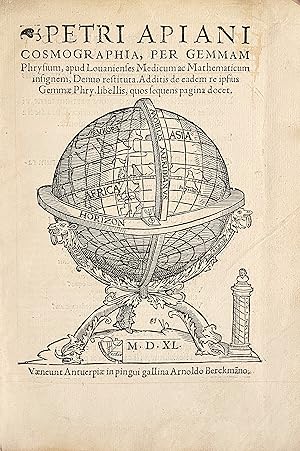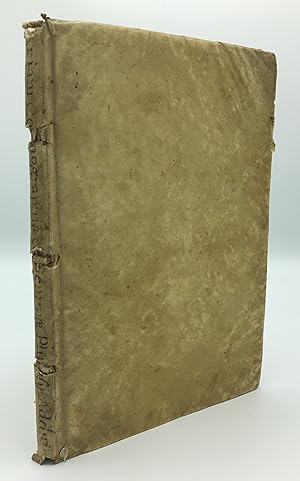apianus petri apiani (3 résultats)
Type d'article
- Tous les types d'articles
- Livres (3)
- Magazines & Périodiques
- Bandes dessinées
- Partitions de musique
- Art, Affiches et Gravures
- Photographies
- Cartes
-
Manuscrits &
Papiers anciens
Etat
- Tous
- Neuf
- Ancien ou d'occasion
Reliure
Particularités
- Edition originale
- Signé
- Jaquette
- Avec images (2)
- Sans impression à la demande
Pays
Evaluation du vendeur
-
COSMOGRAPHIA
Edité par Haeredes Arnoldi Birckmanni, Coloniae Agrippinae (Colonia, Alemania), 1574
Vendeur : Berrocal Libros Antiguos, Madrid, Espagne
Livre
Pergamino. Etat : Bien. 4º (21x16cm). [2] h. 64 h. [2] h. Encuadernación en pergamino de época. Ilustrado con numerosos grabados, bellas capitulares y con esferas móviles. Texto en latín. Falto de la carta cosmográfica y restaurada una hoja del interior. Pedro Apiano (1495-1552), matemático alemán al servicio del emperador Carlos V, fue uno de los primeros cosmógrafos en proponer que los movimientos de la luna permitían hallar la diferencia de meridianos y determinar la situación de un navío en el mar. En esta obra realiza una descripción del mundo y sus partes en relación a la forma de la tierra, las estaciones y los climas, la geografía o la astronomía. Contiene un opúsculo de Regnier Gemma Frisius (1508-1555) sobre la manera de levantar el mapa de un territorio mediante la observación de ángulos y la medida de distancias, usando para ello un instrumento llamado anillo astronómico.
-
Cosmographia, per gemmam Phrysium, apud Louanienses Medicum ac Mathematicarum insignem, Denuo restituta. Additis de eadem re ipsius Gemmae Phry. Libellis, quos sequens pagina docet.
Date d'édition : 1540
Couverture rigide. Etat : Très bon. Anvers, 1540. Voeneunt Antwerpiae in pingui gallina Arnoldo Berkmâno. ({Colophon} Excusum Antuerpiae opera Aegidij Copenij. Anno à Christo nato. 1540.)In-4 de 62 feuillets (Sabin indique 61 feuillets) bien complet du feuillet de marque avec texte au recto. Demi vélin ancien. 233 x 160 mm. --- Troisième édition latine. La première traduction française ne paraîtra que plusieurs années plus tard.Brunet, I, 342, Van Ortroy, Bibli. de l'oeuvre de Pierre Apian, n° 31. Sabin, 1745.Célèbre ouvrage illustré de nombreux et superbes bois, de 5 volvelles avec parties mobiles aux feuillets x verso xi verso (la partie mobile manque ici) : xiii verso, xxix recto ; et xlv recto)Les volvelles montrent notamment les mouvements des planètes et permettent d'en déduire les longitudes, méthode qu'Apianus fut l'un des premiers à découvrir et qui fut utilisée jusqu'au xixè siècle.L'auteur de l'ouvrage, Petrus Apianus, nom latinisé de Bienewith (1495-1552) astronome et géographe, fut à partir, de 1520 professeur de mathématiques et d'astronomie à l'université d'Ingolstadt qu'il ne quitta plus, malgré les offres les plus séduisantes de l'empereur Charles Quint, qui l'anoblit. Apianus proposa le premier la méthode employée pour les longitudes terrestres et consistant à observer d'abord la distance de la lune à quelque étoile fixe près de l'écliptique, et de suivre les mouvements ultérieurs de la lune par rapport à cette étoile. Son élève Gemma Frisius, mathématicien et professeur de Mercator et Jean de Rojas, corrigea le texte et ajouta d'importantes additions sous son propre nom.Contrairement à ce qu'indique Sabin, nous avons pu établir qu'il ne fallait pas de carte dans l'édition de la cosmographie de 1540.Selon van Ortray (Bibliographie de l'?uvre de Pierre Apian, 1902) cette carte apparaît dans la première édition française (15 44 ; van Ortray, n° 33), puis dans une édition hollandaise (van Ortray, n° 35). La première édition l /// Antwerp, 1540. Voeneunt Antwerpiae in pingui gallina Arnoldo Berkmâno. ({Colophon} Excusum Antuerpiae opera Aegidij Copenij. Anno à Christo nato. 1540.)4to [233 x 160 mm ] of 62 leaves (Sabin mentions 61 leaves), complete with the leaf with the mark with text printed on the front. Old half-vellum. --- Third Latin edition. The first French translation will only be published a few years later. Brunet, I, 342 ; Van Ortroy, Bibli. de l'?uvre de Pierre Apian, n° 31 ; Sabin, 1745.Famous work illustrated with numerous and beautiful woodcuts, 5 volvelles with mobile parts on the verso of leaves X, XI (the mobile part is missing here), verso of leaf XIII, recto of leaves XXIX and XLV.The mobile parts notably show the motions of planets, and allow the deduction of longitudes, method that Apianus was one of the first to discover and that was used until the 19th century. The author of the work, Petrus Apianus, Latinized name of Bienewith (1495-1552), astronomer and geographer, was from 1520, teacher of mathematics and astronomy at Ingolstradt University, a position that he wouldn't leave, despite Emperor Charles V's very seducing offers, who ennobled him. Apianus was the first to suggest the method used for terrestrial longitudes, consisting in first observing the distance from the moon to one fixed star near the ecliptic and to follow the subsequent motions of the moon with regard to this star. His pupil Gemma Frisius, mathematician and teacher of Mercartor and Jean de Rojas, corrected the text and added significant additions under his own name.Contrary to what Sabin mentions, we could establish that no map is required in the 1540 edition of the Cosmography.According to van Ortroy (Bibliographie de l'?uvre de Pierre Apian, 1902), this map was first published in the first French edition (1544 ; van Ortroy, n°33), then in a Dutch edition (van Ortroy, n°35). The first Latin edition to contain this map is the 1545 edition (van Ortroy, n°36).Beautiful wide-margined.
-
COSMOGRAPHIA, per gemmam Phrysium, apud Louanienses Medicum ac Mathematicarum insignem, Denuo restituta. Additis de eadem re ipsius Gemmae Phry. Libellis, quos sequens pagina docet.
Edité par Antwerp: Arnoldo Berckmâno [Arnold Birckmann]., 1540
Vendeur : Sky Duthie Rare Books, Sheffield, Royaume-Uni
Membre d'association : PBFA
Livre
Early Latin edition. Quarto (160 x 222mm). Full contemporary or near-contemporary vellum over boards with titles in manuscript to the spine. Illustrated with 51 woodcuts and 5 volvelles (4 with moveable parts) to the verso of leaves X, XI (with the moveable element absent, as appears to always be the case, and seemingly as issued), XIII, and to the recto of leaves XXIX and XLV. Historiated initials throughout, globe woodcut to the title page, woodcut printer's device to the verso of the final printed leaf. Somewhat enigmatically inscribed in an early hand to the foot of the title page "Georgy dati Florentini" (George of Florence), and further inscribed to the verso of the final printed leaf. A very good copy, the binding secure, although with some cracking in places, and the spine covering with loss at the sewing supports. The contents with a minor mark to the head of the title page and some nibbling to the top-right corner of the final 13 leaves (not affecting the text) are otherwise in very good order. An early edition of Petrus Apianus's (1495-1552) first major work - a milestone in Renaissance geography and one of the most popular books on cosmography ever published. A highly influential work, Apianus's treatise was one of the first attempts to base geography on mathematics and measurement. Originally published in 1524, it went through no fewer than 45 editions, was translated into 14 languages, and was manufactured in seven cities, by at least 18 printers. This popularity derived principally from its maps and discussion of the New World, but also for its ingenious use of volvelles, or paper devices, which enabled one to solve practical mathematical problems relating to time, the calendar, astronomy and astrology. The work is divided into two main parts; the first discussing the principles of cosmography, and the second providing cosmographical data, including a general geographical description of the four continents. Its essential purpose was to provide readers with a brief explanation of the basic concepts of astronomy and geography, to explain how to find latitude, longitude and time with mathematical instruments, to provide arithmetical methods for converting differences in coordinates to distances, and to explain how to draw a cosmographical map, with its numerous woodcut illustrations serving to demonstrate the astronomical, cartological, mathematical and geographical concepts under discussion. Among the instruments depicted is an armillary sphere, portable time telling devices, including a diptych and nocturnal, annulus astronomicus or astronomical rings and an astrolabe. The volvelles themselves comprise a horizon instrument (X), demonstrating the relationship between the local horizon, the zenith, the polar axis and the equator; a circular calendar without moveable parts (XI), the outer scale showing the Zodiac, with each sign divided into 30 degrees, the lower left quadrant of the inner disc being used to tell the time in unequal hours - widely used in the 16th century - and with the right quadrant showing a shadow square, a proportional measuring device often used to measure heights at a distance; an altitude sun dial (XIII), termed Ptolemy's Instrument by Apianus, which can be used to tell time in any latitude, thus forming a universal instrument, which can also tell the times of sunrise and sunset and provide the lengths of day and night in any latitude; a terrestrial astrolabe (XXIX) equipped with a geographical or map-plate, indicating the latitude and longitude of a region, the movement of the sun as seen from the earth, and the relative time in different parts of the earth; and a lunar clock (XLV), which, in conjunction with a sundial, can be used to determine time at night. This edition, edited by Apianus's student Gemma Frisius (1508-1555), contains the latter's description of Peru, as well as an account of the discovery of America by its namesake, Amerigo Vespucci, in 1497 (XXXI). All editions of the Co.




